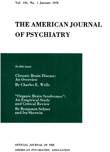INVESTIGATION OF THE THERAPEUTIC COMPONENTS AND VARIOUS FACTORS ASSOCIATED WITH IMPROVEMENT WITH ELECTROCONVULSIVE TREATMENT: A PRELIMINARY REPORT
Abstract
1. This is a preliminary report of a study designed to investigate the mode of action of ECT and the degree to which various physiological, biochemical and psychological factors in patients were related to its effectiveness. Thirty-six patients were assigned at random to a course of 1 of 5 treatment methods: ECT; ECT with anectine; ECT with Pentothal; Pentothal; and nitrous oxide.
2. There were no significant differences among the 5 treatment groups with respect to improvement. When just schizophrenic patients without clinical depression were studied, the results obtained by ECT were the same as those obtained by repeatedly rendering the patient unconscious by Pentothal or nitrous oxide. Consistent with clinical experience, there was a greater degree of improvement seen in patients with clinically evident depression than in those with no clinical depression, regardless of type of treatment received.
3. Contrary to expectations, patients with no sign of "self-expressed depression" and without "exaggerated guilt" improve most often.
4. Some confirmation was obtained of the predictive value of the Funkenstein test, and weak but better than chance relationships were found between improvement and protein bound iodine, serum potassium, serum calcium, spinal fluid potassium, blood uric acid and blood total catecholamines. An increase in 17-ketosteroid excretion as well as improved adrenocortical response to stress appeared to be related to improvement.
5. The psychological test variables which related best, although weakly, with improvement were "the potential for psychopathology" and "anxiety."
6. Improvement was found to be weakly associated with general fearfulness, expectation of death from treatment and nonverbalized fear of shock treatment. The findings suggest that there is some relationship between fear of treatment and improvement. However, it clearly is not strong enough (as determined here) to explain adequately the mode of action of shock treatment, nor in itself, to be a reliable prognostic tool.
7. Fear of shock treatment seemed to be universal in the patients studied but the design of the study did not provide adequately for the determination of the unconscious meaning of the treatment to the patients.
Access content
To read the fulltext, please use one of the options below to sign in or purchase access.- Personal login
- Institutional Login
- Sign in via OpenAthens
- Register for access
-
Please login/register if you wish to pair your device and check access availability.
Not a subscriber?
PsychiatryOnline subscription options offer access to the DSM-5 library, books, journals, CME, and patient resources. This all-in-one virtual library provides psychiatrists and mental health professionals with key resources for diagnosis, treatment, research, and professional development.
Need more help? PsychiatryOnline Customer Service may be reached by emailing [email protected] or by calling 800-368-5777 (in the U.S.) or 703-907-7322 (outside the U.S.).



